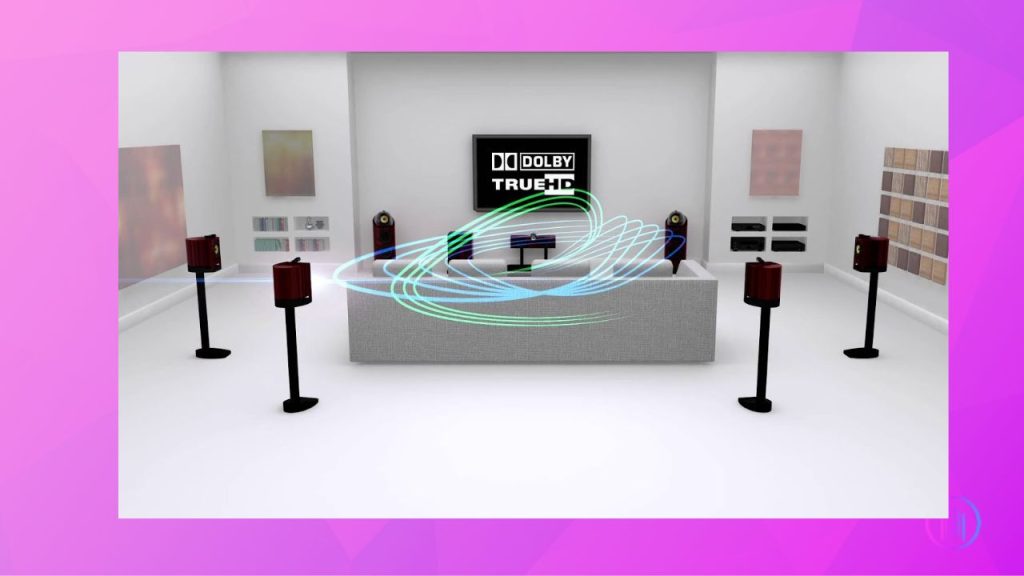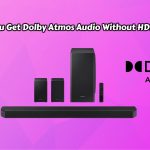Quick Answer: Dolby TrueHD offers lossless, high-quality audio up to 7.1 channels. Dolby Atmos enhances this with 3D positioning for a more immersive experience.
I recently faced a choice for my home theater system: Dolby TrueHD or Dolby Atmos? At first, I didn’t know much about either. So, I started looking into them to understand better. What I found was quite interesting! In this article, I’m going to share with you everything I learned. You’ll get to know about the key features of both Dolby TrueHD and Dolby Atmos. I’ll also explain how they are different and what each can do for your home theater experience. By the end, you’ll have a clearer picture of which sound technology will make your movie nights really special.
Dolby TrueHD:

Let’s just get straight into facts.
First of all, one prominent feature of Dolby True HD is that it’s a lossless audio codec developed by Dolby Laboratories, which is widely used with Blu-ray Discs. It provides a channel-based audio transmission and can support up to 7.1 channels of lossless audio transmission.
Although it transmits audio through a compression technique, when decoded, the uncompressed form of audio is no different from the original recording. It means you will hear the same audio as witnessed at the recording time.
What does it mean?
It means that if you’re watching a movie scene where the leaves are rustling because of the blowing wind, it would sound surreal as if you’re sitting and hearing the sound in reality. You won’t lose even the faintest sound in the movie.
Knocked down with a feather after knowing these fantastic features, aren’t you?
In addition, the Dolby True HD retains every bit of the recorded data before compressing, making the file heavier and larger than usual. However, the quality makes it worth every bit.
Dolby Atmos:

Among all the sound formats developed by Dolby Laboratories, Dolby Atmos slays the top chart. So, when you hear the Dolby Atmos inclusion in someone’s home theater, know that the Eagle has hit the jackpot.
Unlike Dolby TrueHD, Dolby Atmos is an object-based 3D surround sound audio format, which makes your home theater unprecedented. It can play up to 128 sound objects for a 3D audio experience. Furthermore, there are no certain designated speakers for specific sounds. Instead, the decision is based on the show and the current situation of the scene.
Finally, this amazing audio codec cannot work alone despite its outstanding features. It’ll either work with Dolby TrueHD with lossless, uncompressed audio or Dolby Digital Plus (lossy sound).
Dolby TrueHD – The Technical Lowdown:
When we talk about Dolby TrueHD, we’re diving into the realm of lossless audio codecs. What does this mean for you? Well, it’s all about getting that pristine, studio-quality sound right in your living room. It’s like having a private concert every time you hit play!
- Bitrate and Sampling Rate: Dolby TrueHD brings the noise with up to 24-bit audio and sampling rates from 44.1 kHz to 192 kHz. This is like having your cake and eating it too, but in the audio world—it means high-fidelity, crystal-clear sound that’s music to your ears.
- Channel Support: With support for up to 7.1 audio channels, Dolby TrueHD is all about that immersive, surround sound experience. It’s like being wrapped in a blanket of high-quality audio.
- Compatibility: Whether you’re a Blu-ray aficionado or rocking HDMI eARC-enabled devices, Dolby TrueHD has got you covered. It’s like the universal remote of audio codecs—it just works with everything!
- Data Rate: On the technical side, Dolby TrueHD has an average data rate of around 6,000 kbps, peaking at 18,000 kbps for those high sampling rate multichannel jams. It’s all about packing in that audio goodness!
Dolby Atmos – Elevating Your Audio:
Now, let’s chat about Dolby Atmos. This tech is a game-changer, literally elevating your sound experience to new heights with its object-based audio format. It’s like stepping into a whole new world of sound!
- Object-Based Audio Format: Imagine being able to place up to 128 sound objects anywhere in a 3D space. That’s Dolby Atmos for you—creating an immersive sound experience that’s nothing short of magical.
- Height Channels: Dolby Atmos adds another layer to your audio with height channels. Whether it’s overhead speakers or ones bouncing sound off the ceiling, it’s about adding a vertical dimension to your audio experience. It’s like having sound rain down on you!
- Flexibility and Compatibility: Dolby Atmos is like the Swiss Army knife of audio tech. It can roll with both Dolby TrueHD and Dolby Digital Plus, offering a range of audio transmission and processing options. And if your device isn’t Atmos-friendly, no worries—it’s got backward compatibility in the bag!
- Priority and Integration: When your device is vibing with both Dolby TrueHD and Dolby Atmos, Atmos takes the lead in audio decoding. It seamlessly integrates with Dolby TrueHD, adding a 3D sound field that’s just next level.
A Quick Comparison:
- Transmission Methodology: Dolby TrueHD is all about channel-based audio transmission, delivering high-quality, lossless sound through specific channels. On the flip side, Dolby Atmos is rocking the object-based audio transmission, allowing for free placement of sound objects in a 3D space.
- User Experience: Dolby TrueHD offers an immersive experience with lossless audio across up to 7.1 channels. But Dolby Atmos kicks it up a notch, adding a vertical dimension and allowing sound to come from above for a more enveloping experience.
- Hardware Requirements: Both are pretty flexible but they do require HDMI eARC for optimal transmission of uncompressed data and support from AV receivers and speakers. And for Dolby Atmos, you’ll need either ceiling speakers or speakers capable of bouncing sound off the ceiling to create those height channels.
The combat: Dolby TrueHD VS Atmos
Let’s hop into a bit of comparison to understand the difference between these two audio codecs clearly.
Audio Transmission:
The first significant difference between the two is the transmission of audio. Dolby TrueHD is a channel-based audio. It can support up to 7.1 channels, including the lossless, uncompressed sound transmission, for an immersive listening experience.
On the other hand, Dolby Atmos is an object-based sound format that creates and transmits audio through up to 128 sound objects. Furthermore, this audio format can be delivered through multiple audio codecs, including Dolby TrueHD and Dolby Digital Plus.
Backward Compatibility:
If your AV receiver or speakers don’t support Dolby Atmos audio, Atmos is capable of backward compatibility. Since Atmos is an extension of Dolby TrueHD, the data will be folded in the bit stream for the Atmos incompatible device; it will convert the Dolby Atmos to Dolby TrueHD. As a result, you’ll hear the Atmos audio in the form of Dolby TrueHD.
On the contrary, Dolby TrueHD will not be able to provide you with Dolby Atmos sound if your devices are not Dolby Atmos compatible.
Audio priority:
If you want to know which one holds precedence in audio priority in Dolby TrueHD vs. Atmos combat, it’s undoubtedly Dolby Atmos. If your AV receiver/speakers support Dolby TrueHD and Dolby Atmos, your speakers will decode Atmos data to produce audio.
Hardware compatibility:
Both Dolby Atmos and Dolby TrueHD transmit uncompressed data, meaning the audio file is larger than the usual compressed audio data files. For this reason, you must use an HDMI eARC connection, as it has a larger bandwidth to support the transmission of larger files.
Furthermore, You will have to use an HDMI 2.1 cable to support the file transmission without any data loss.
Speakers setting:
The speaker setting in Dolby TrueHD is like a 7.1 surround sound setup. It comprises eight speaker channels, including one speaker in the front, two front-left and front-right speakers, one subwoofer, one surround-left and surround-right speaker, and Finally, the Dolby TrueHD setup includes two rear speakers, which serve to add more depth to the audio experience.
Atmos, on the other hand, comes with ceiling speakers, which provide an utterly enveloping sound experience to the listener.
To sum up!
The names of the two Audio formats may look alike; however, there’s a significant difference between these two. Dolby TrueHD is a channel-based audio codec that can support up to 7.1 channels and is widely used with Blu-ray discs; it’s supported by HDMI eARC-enabled devices and transmits uncompressed lossless sound. Atmos, on the contrary, is an object-based audio format that can transmit data in the form of Dolby TrueHD or Digital Plus.
If you’ve read all the way to the end of this article, you should now have a clear understanding of the differences between these two formats.
However, if you have skipped the part, then go ahead and join the lot who refused to stand out by knowing the difference between TrueHD and Atmos. Well, the bargain is simple; knowing the two can help you bring a revolutionary change to your home theater. If you want to delve deeper into the specifics of Dolby Digital vs Dolby Atmos, check out our in-depth comparison here.
So, are you ready for the change?

I’m Shaun Conroy, an audiophile & founder of HiFi Audios. Holding a Bachelor’s in Sound Engineering, I bring deep expertise in audio devices and offer insights & recommendations to fellow enthusiasts.





